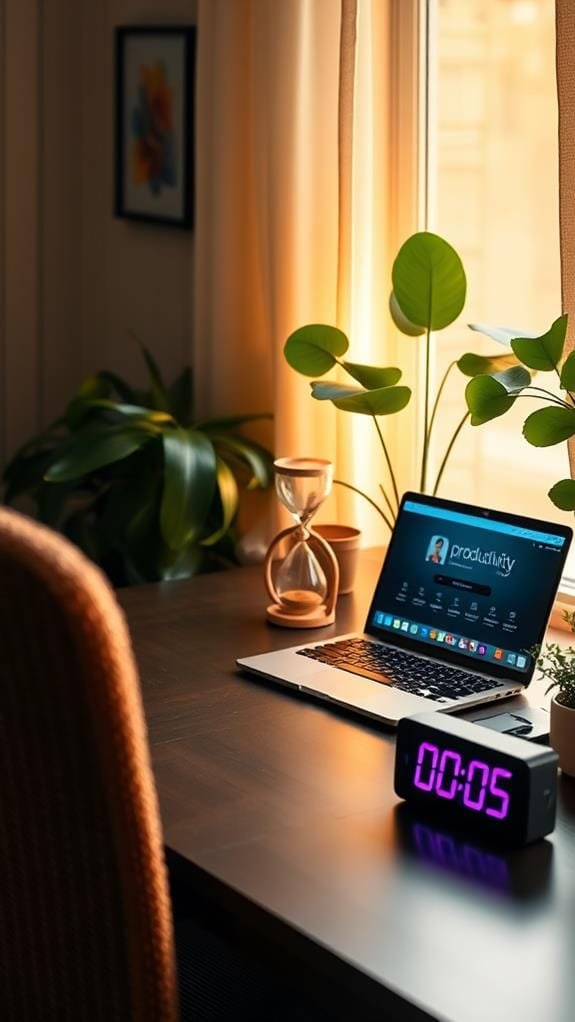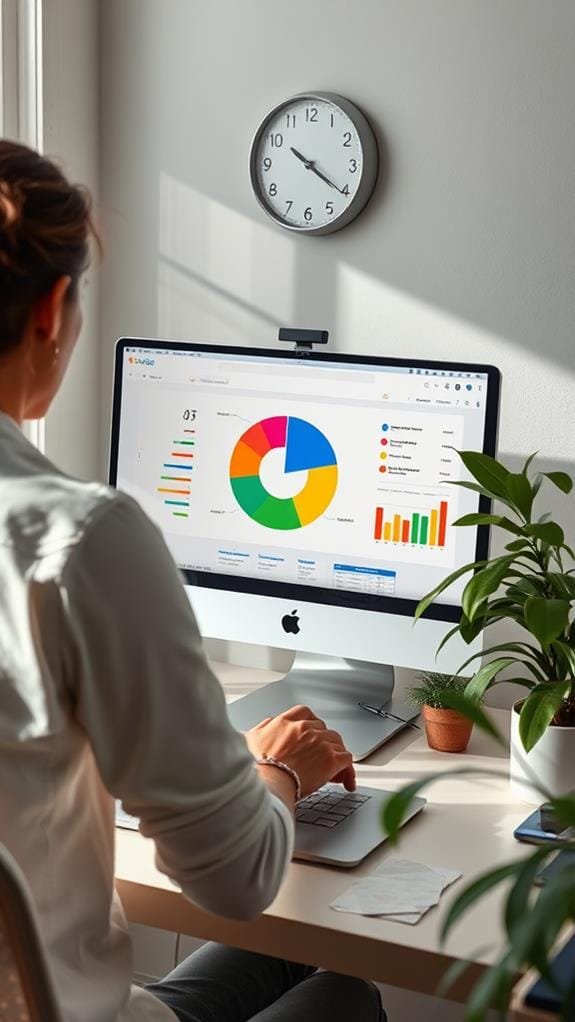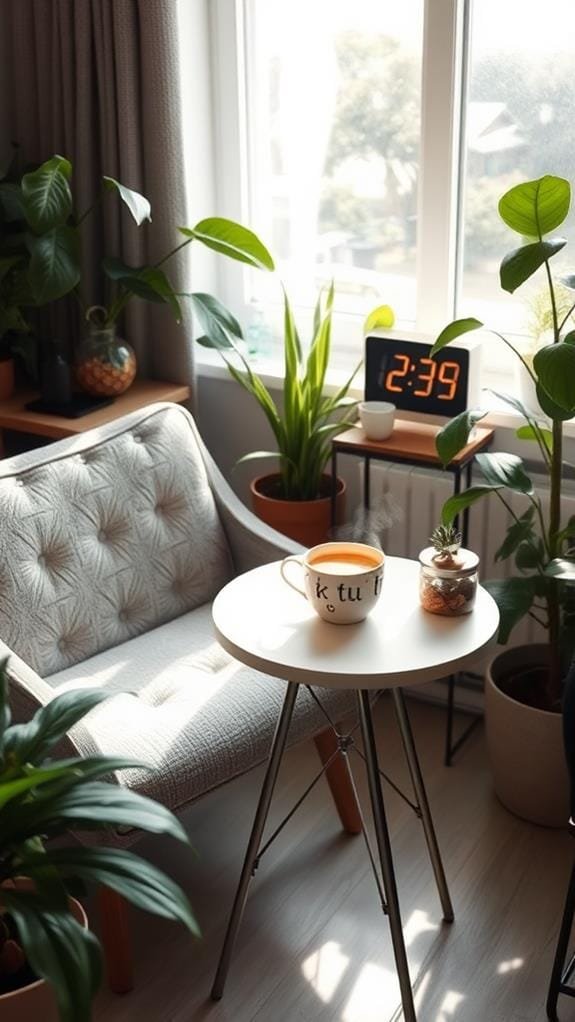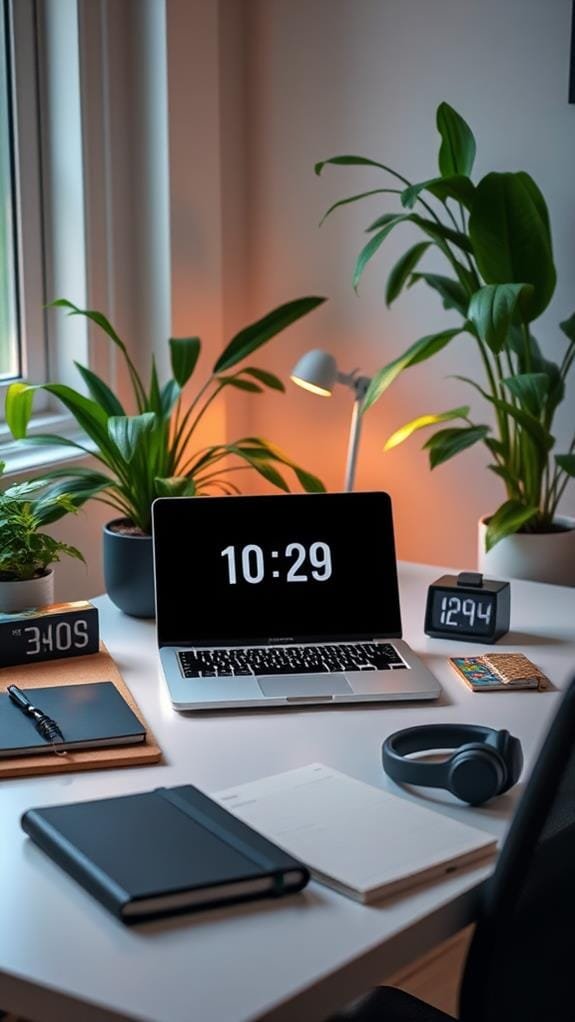To manage your screen time without sacrificing productivity, start by understanding digital wellness. Reflect on your usage patterns and utilize tracking apps to identify where your time goes. Set clear boundaries, like creating device-free zones at home or establishing usage limits, to minimize distractions. Schedule mindful breaks—just a few minutes can recharge your focus and boost mood. Explore productivity tools like the Pomodoro Technique or task management apps to streamline your workflow. By being intentional and aware of your digital habits, you can enhance both your mental health and effectiveness. There's so much more to explore on this journey!
Key Takeaway
- Monitor and track your screen time to identify patterns and make informed adjustments to enhance productivity and digital wellness.
- Set specific limits for device usage, creating device-free zones to foster focus and reduce distractions in your environment.
- Incorporate short, mindful breaks throughout your workday to recharge and maintain high levels of productivity without burnout.
- Utilize productivity apps like Todoist or Trello to organize tasks efficiently, helping manage time while minimizing unnecessary screen engagement.
- Practice the Pomodoro Technique to structure work intervals and breaks, enhancing concentration and supporting overall digital wellness.
Understanding Digital Wellness

In today's fast-paced digital world, understanding digital wellness is essential for maintaining a healthy relationship with technology. You might not realize how much your screen time can affect your emotional balance and overall well-being. By practicing mindful consumption, you can take control of your digital habits and create a safer, more fulfilling experience online.
Mindful consumption means being intentional about how and when you engage with technology. It's not just about limiting your screen time; it's about being aware of the content you consume and how it makes you feel. Ask yourself, "Is this information uplifting and informative, or is it draining my energy?" By filtering out negativity and focusing on positive content, you can nurture your emotional balance.
Take a moment to notice how technology impacts your mood. Are you scrolling through social media and feeling anxious, or are you engaging with content that inspires you? Recognizing these emotions is key to digital wellness. When you prioritize mindful consumption, you're not just protecting your mental health; you're also cultivating a healthier online environment.
Assessing Your Screen Time

Awareness of your screen time can greatly enhance your digital wellness journey. By understanding how much time you spend on different devices, you can take control of your habits and prioritize your well-being. The first step is to ponder self-reflection techniques that help you evaluate your usage patterns. Ask yourself: Are you scrolling mindlessly through social media, or are you engaging in productive tasks? Recognizing the difference is key.
Next, you might want to explore tracking applications. These tools can be incredibly helpful in providing insights into your daily screen time. Many apps can categorize your usage, showing you where your time goes. You'll likely find surprises along the way—those "quick checks" of your phone can add up!
As you gather this information, start noticing trends. Do you use your devices more during certain times of the day? Are there specific apps that seem to steal more of your time than others? This level of awareness empowers you to make informed choices about your digital habits.
Setting Boundaries for Device Use

Recognizing your screen time patterns sets the stage for establishing effective boundaries around device use. Once you've got a handle on your habits, it's time to take action. Start by creating device-free zones in your home. These could be your dining area, bedroom, or even your backyard. By designating specific spaces where devices aren't allowed, you cultivate an environment that encourages connection, relaxation, and focus.
Next, practice mindful usage. Before picking up your device, ask yourself what you really need to accomplish. Are you scrolling mindlessly, or are you using your device for a specific purpose? Setting clear intentions can help you stay on track and avoid unnecessary distractions. Try setting limits on your usage, like only checking emails during designated times. This approach not only keeps you productive but also reduces the temptation to get lost in a digital rabbit hole.
It's also beneficial to involve family or roommates in these boundary-setting efforts. Share your goals and encourage them to create their own device-free zones. This collective approach fosters a supportive environment, making it easier for everyone to stay accountable.
Incorporating Breaks and Downtime

How can you effectively recharge amidst a screen-dominated life? It's crucial to incorporate breaks and downtime to maintain your well-being. By scheduling mindful moments throughout your day, you can prevent burnout and enhance your productivity. Think of these breaks as mini-vacations for your mind, allowing you to step away from the screen and recharge.
Engaging in restorative activities can make a world of difference. Try stretching or taking a short walk outside—nature can work wonders for your mood and energy levels. Even simple breathing exercises can help clear your mind and refocus your thoughts. These moments don't have to be long; even five minutes can refresh your perspective.
When you take a break, consider setting a timer. This way, you'll stay committed to your downtime while ensuring you return to your tasks energized. You might also explore hobbies you love, like reading or drawing, to infuse joy into your day. These activities can serve as excellent alternatives to screen time, providing a creative outlet and a chance to unwind.
Remember that downtime isn't just a luxury; it's a necessity for maintaining a healthy balance. By prioritizing breaks, you're investing in your mental health and overall productivity. So, don't hesitate to create a routine that includes these mindful moments. After all, a well-rested mind is a more effective one.
Tools to Enhance Productivity

After taking those much-needed breaks, it's time to amp up your productivity with the right tools. You can leverage productivity apps that help streamline your tasks and manage your time efficiently. With so many options available, finding the perfect fit for your workflow can feel like searching for a needle in a haystack—but don't worry, you've got this!
First, consider time management apps like Todoist or Trello. These apps let you create to-do lists, set deadlines, and track your progress. By breaking down tasks into manageable chunks, you'll feel less overwhelmed and more in control. Plus, the satisfaction of checking off completed items is hard to beat!
Another great option is the Pomodoro Technique, which many productivity apps incorporate. You work for 25 minutes, then take a 5-minute break. This method not only helps maintain focus but also encourages those essential breaks we talked about earlier.
To make your environment conducive to productivity, consider apps like Freedom or Cold Turkey. They block distracting websites and notifications, letting you dive deep into your work without interruptions. Remember, creating a safe and distraction-free zone is key to enhancing your focus.
Incorporating these tools into your routine can greatly boost your productivity while keeping your digital wellness in check. Now, get ready to tackle your tasks like a pro! Just remember to give yourself grace and enjoy the journey!
Frequently Asked Questions
How Can I Convince My Team to Prioritize Digital Wellness?
To convince your team to prioritize digital wellness, highlight how wellness strategies boost team engagement. Share success stories, encourage open discussions, and create a safe environment where everyone feels comfortable sharing their experiences and suggestions.
What Are Some Signs of Digital Burnout I Should Watch For?
Watch for signs of digital burnout like persistent digital fatigue, increased screen stress, and difficulty concentrating. If you're feeling overwhelmed or detached, it's time to take a break and reassess your screen habits.
Are There Specific Apps That Help Monitor My Screen Time?
You might think monitoring screen time feels restrictive, but it actually empowers you. Consider apps like Moment or RescueTime for effective screen tracking. They provide valuable insights, helping you balance usage while ensuring your safety and productivity.
How Does Digital Wellness Impact Mental Health?
Digital wellness fosters mindful technology use, enhancing mental clarity and emotional resilience. By prioritizing a digital detox, you can reduce stress and anxiety, promoting a healthier mindset and ultimately improving your overall mental health.
Can Digital Wellness Improve My Work-Life Balance?
Think of digital wellness as a compass guiding you through life's chaos. By setting personal boundaries and using mindful technology, you'll create a healthier work-life balance, ensuring safety and well-being in your daily routine.
Conclusion
Finding balance in your digital life isn't just about cutting back; it's about enhancing your productivity and well-being. By evaluating your screen time, setting boundaries, and incorporating breaks, you can reclaim your focus and energy. Embrace tools that work for you, and remember: less distraction means more creativity, more mindfulness, and more joy. So, take charge of your devices, and let them serve you, not the other way around. You've got this!





